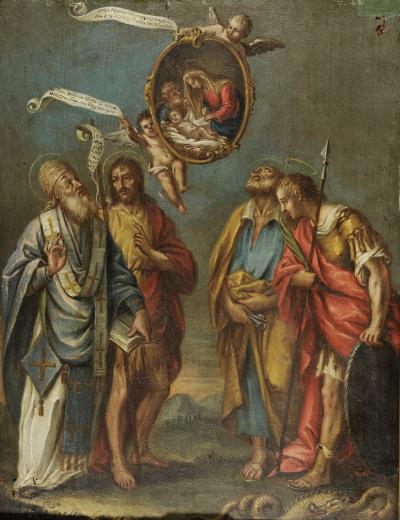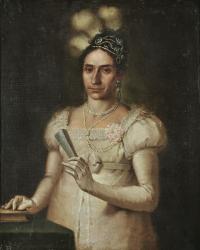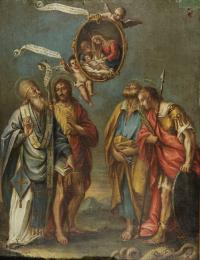Άγιος Σπυρίδων, Άγιος Γιάννης ο Βαπτιστής και δύο άλλοι Άγιοι
 Work Artirst Modal
Work Artirst Modal
Άγιος Σπυρίδων, Άγιος Γιάννης ο Βαπτιστής και δύο άλλοι Άγιοι
Koutouzis, Nikolaos (1741 Zakynthos - 1813 Zakynthos)
Possibly trained at the studio of Nikolaos Doxaras in Zakynthos, in 1757 he produced under the latter's supervision Saint Ioannis Damaskinos and Saint Varvara for the church of Saint Dimitrios of Kollas, but neither of these works has survived to the present day. Sometime between the years 1760-1764, he is believed to have travelled to Venice, but in 1766 he was back in Zakynthos to paint the Procession of Saint Dionysios, a signed and dated painting, located in the women's gallery of the church of Saint Dionysios. In 1770, he was wounded in the face during a fight. In 1777, he was ordained priest in Lefkada and then became a rector in churches of his birthplace. Parallel to his painting and clergy work, he probed into satirical poetry, strongly criticizing the state of affairs of his time, while his eccentric behavior, as well as his subversive and theatrical way of delivering the liturgy, brought him in conflict with his social environment. Three religious painting compositions from churches of Zakynthos, more specifically the churches of Saint Spyridon Flabouriaris, Saint Georgios Petroutsos and Saint Antonios Andritsis, are attributed to N. Koutouzis. Also his is the portrayal of the Birth of the Virgin Mary on the ceiling of the “Panagia ton Xenon” church in Corfu, as well as four paintings at the monastery of Saint Dionysios in Zakynthos featuring themes from the life of the namesake Saint.
A predominant figure in the Ionian arts during the 18th and early 19th century, he mainly developed the religious scene, while he is also considered to have had a most significant contribution in the shaping of secular portrait painting. He adhered to the standards of Italian Baroque and clashed with the tradition of post-Byzantine art, at the level of both technique and visual negotiation. His work was influencial among his peers, finding its continuation in the paintings of his student Nikolaos Kantounis.

Σε αυτό το έργο ο Κουτούζης ακολούθησε τα πρότυπα του ιταλικού μπαρόκ και ήλθε σε ρήξη με την παράδοση της μεταβυζαντινής τέχνης, τόσο σε επίπεδο τεχνικής όσο και σε επίπεδο εικαστικής διαπραγμάτευσης. Ακολουθώντας τα δυτικά πρότυπα αποδίδει ρεαλιστικά το τοπίο στο βάθος με τη χρήση της προοπτικής και σε χρωματισμούς, τόσο στο φόντο όσο και στα ενδύματα των προσώπων, που συγγενεύουν με τη βενετσιάνικη παράδοση.





 Π.Ε.Π. ΙΟΝΙΩΝ ΝΗΣΩΝ
Π.Ε.Π. ΙΟΝΙΩΝ ΝΗΣΩΝ

